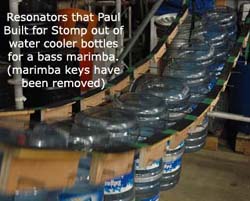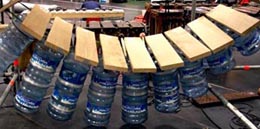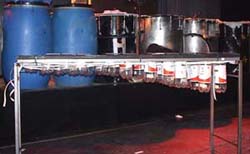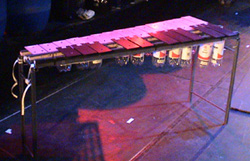Hey
Colin
The keys will
always sound a little ‘dead’ until you have two things in place (a) a mounting
mechanism that will allow it to vibrate freely and (b) something to amplify the
sound, i.e. a resonator.
(a) Temporary
mounting
Place the bar
resting on its nodes on some rope or a couple of part-inflated long balloons or
some light sponge, you should hear a clearer note then.
(b) resonators –
this is a more complicated element of the build. Basically you require a sealed
‘vessel’ open at the end directly below the mari mba key. This can be
mba key. This can be
anything really as long as it fits under the bar and can be cut to length. Go
for the widest vessel that you can physically fit in there as this will maximise
volume. Reso length will affect the pitch of the resonator and reso width will
affect amplitude (volume) with wider being louder. The reso needs to be really
tight to the key 1" – too tight will flatten the resonated note, too far will
make the note weak. 
 There is a formula for
There is a formula for
calculating the reso length
-
Take
the Speed of sound (33,500mm/s) -
Multiply the Desired frequency (hz) by 4
-
divide
the speed of sound by the result of step 2 -
The
result in mm is the length of the resonator.
Ok so if maths
isn’t your thing, try this… Take a plastic bottle and cut it off on the
vertical bit below the shoulder. Place the bottle with the open end beside your
ear. Sing a glissando, a sliding note from high note to low note. At certain
points you will clearly hear the bottle pick up on your voice and make it
significantly louder – that’s it resonating the note, each t ime it does that you
ime it does that you
have matched either an harmonic or the fundamental. If you place a marimba bar
of the same note over the bottle  and hit the bar then
and hit the bar then
the magic happens.
To tune the bottle
you simply use scissors to trim the plastic away and raise the resonated
frequency until it is resonating at the pitch you want. I used this singing
technique to build resonators (seen above) at home near Belfast for an
instrument that was 500miles away in the Stomp workshop – it worked
perfectly.
You will notice on
the assembled instrument to the left that the last two resonators are about the
same length. In this case, the lower one has had the top closed over slightly.
Restricting the size of the opening will also lower the note – I uses this a lot
on the bass and baritone marimbas otherwise the resonators would be many feet
long. It does have an effect on volume however so you need to work out effective
ranges.
Hope this
helps
Paul
